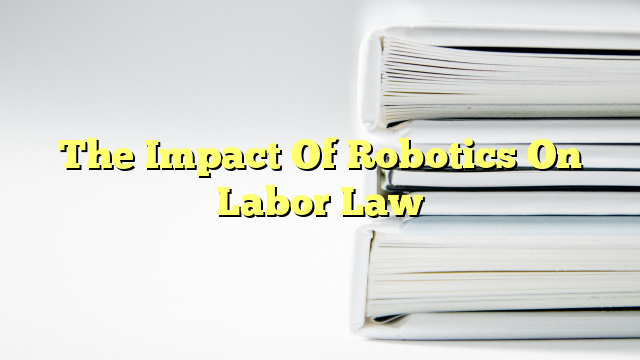Introduction
Robotics is a term that is used to refer to the use of machines that are programmed to do a variety of tasks. Robots are used in many different industries and have revolutionized the way that work is done in the modern world. Robotics has had a great impact on the labor market, and the effects of robotics on labor law can be seen in many different areas. This article will discuss the impacts of robotics on labor law, the advantages of using robots in the workplace, and the potential threats that robotics poses to human labor.
Impact of Robotics on Labor Law
Robotics has had a profound impact on labor law and the regulation of the workplace. As robots are increasingly used in the workplace, labor laws must be adapted in order to keep up with the changing landscape. For example, many states have passed legislation that requires employers to provide appropriate training and safety measures when using robots in the workplace. Additionally, labor laws must be updated to ensure that robots are not used to replace human workers, as this could potentially lead to displacement of workers.
Labor laws must also be adapted to ensure that robots are not used to discriminate against workers in any way. For example, robots must not be used to select workers for positions based on their gender or race. Additionally, labor laws must be updated in order to ensure that robots are used in a safe and ethical manner, and that any potential risks posed by robots are minimized.
Advantages of Using Robots in the Workplace
Robots can have numerous advantages when used in the workplace. Robots can increase the efficiency of production processes by completing tasks faster and more accurately than human workers. Additionally, robots can reduce the risk of workplace injuries by taking on dangerous tasks that would otherwise be performed by humans. Additionally, robots can be used to complete tedious tasks more quickly, freeing up human workers to focus on more complex tasks.
Robots can also decrease the cost of production by reducing labor costs. As robots do not need to be paid a salary, employers can save money by using robots instead of human workers. Additionally, robots are able to work longer hours without needing breaks or rest, which can further reduce labor costs.
Threats to Human Labor
Although robots can offer many advantages to the workplace, they can also pose a threat to human labor. As robots become increasingly advanced and are able to do more complex tasks, they can potentially replace human workers in many jobs. This could lead to a loss of jobs and a decrease in wages for human workers. Additionally, robots can lead to increased workplace inequality, as they can be used to favor certain groups of workers over others.
In order to reduce the potential threat that robots pose to human workers, labor laws must be updated to ensure that robots are used responsibly. Regulations should be put in place to ensure that robots are not used to replace human workers and that any potential risks posed by robots are minimized. Additionally, labor laws should be updated to ensure that robots are not used to discriminate against any particular group of workers.
Effects of Robotics in Present Day Society
Robotics has had a profound impact on the way that work is done in present day society. Robots are used in many industries and have had a great impact on the labor market. Robotics has led to increased efficiency and productivity in the workplace, as well as decreased labor costs. However, robots can also pose a threat to human labor, as they can potentially replace human workers in many jobs. In order to ensure that the potential benefits of robotics are realized and the potential threats are minimized, labor laws must be adapted to keep up with the changing landscape.


The introduction of robotics in the workplace demands an evolution of labor law. Automation and AI have major implications for employee rights and requires a modern approach to safeguard them.